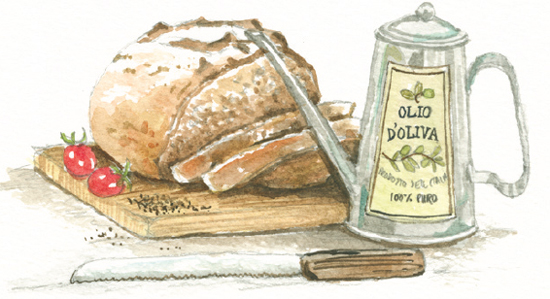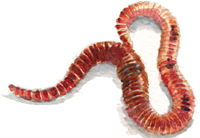

A riddle
Question: What creature has no eyes, ears, nose, teeth, arms or legs? Yet this creature has five hearts; it moves, eats, breathes through its skin, has senses, is both male and female, mates – with both males and females – can live for fifteen years or longer, never sleeps. And makes new earth.
Answer: An earthworm.
With their constant munching and mating, breeding, producing of vermicompost and lack of sleep, what exhausting lives worms live!
There are not a lot of gardening activities at this time of the year, so now would be a good moment to consider making or buying a wormery and producing worm casts, i.e. worm manure.
‘When we behold a wide, turf-covered expanse, we would remember that its smoothness, on which so much of its beauty depends, is mainly due to all the inequalities having been slowly levelled by worms. It is a marvellous reflection that the whole of the superficial mould over any such expanse has passed, and will again pass every few years, through the bodies of worms. It may be doubted whether there are many other animals which have played so important a role in the history of the world as these lowly organized creatures.’
Charles Darwin (1809–82)
Who really respects the earthworm,
the farmworker far under the grass in the soil.
He keeps the earth always changing.
He works entirely full of soil,
speechless with soil, and blind.
He is the underneath farmer, the underground one,
where the fields are getting on their harvest clothes.
Who really respects him,
this deep and calm earth-worker,
this deathless, grey, tiny farmer in the planet’s soil.
Harry Edmund Martinson
From the Swedish (trans. Robert Bly)
Windowsill wormeries
Wormeries are ideal for window-box gardens: a) because they are small, b) because they can, if necessary, be kept indoors, c) because the worms require only small amounts of food, and d) because a working wormery is most interesting to watch.
Some people can’t even bear to hear the word ‘worm’ said aloud, let alone whispered. But after reading about the intriguing life of worms and being introduced to them gradually – perhaps to a baby worm first, and then to the head end of an adolescent – even the most squeamish might overcome their aversion. It is worth it.
Worms have enthusiastic appetites and eat their way through half their own body weight in food each day. Because they have special digestive systems, the results of their banqueting, worm casts (the earth that is excreted by worms), are much richer in nutrients than the original food. Worm-cast compost can be mixed with existing soil when refreshing window-boxes in the spring (see page 42), used as a slow-release top dressing or as an alternative to peat. (If, when in Ireland, you have ever seen peat being machine dug from the body of the land, you will probably never use it again.)
You can make your own wooden wormery (Chase Organics provide instructions – see page 170). Or you can buy one or enquire whether your local council will give you one free (or at a reduced rate), this being the council’s attempt to encourage people to recycle and cut down on the landfill-waste problem. This is an excellent initiative but has its drawbacks: I have tried two council plastic wormeries and neither worked, the result in both cases being a swamp at the bottom of the bins from which the worms, quite understandably, were constantly trying to escape. I also bought what appeared to be an airier version of the council’s wormery. Result: third swamp. Conclusion: worms don’t like living in airless plastic containers. Who would? I have yet to meet a worm composter who has had any success with plastic – or at least with this particular design. I am sorry for those people who have given up worm composting because of failure, because wormeries can work.
The most successful wormery I have had was called a Tiger Worm Compost Bin and was made of recycled newspapers and cardboard. It allowed air to enter and excess moisture to leave and evaporate. Owing to its composition, it won’t last for ever, though mine lasted for several years. At the moment I am experimenting with what might, or might not, turn out to be the simplest and cheapest design of all (see page 104).
In the meantime, while making your own wormery or waiting for an ordered one to arrive, here are a few worm biographical details.
The species generally used for vermicomposting are the red worm (Eisenia andrei) and the tiger worm (E. fetida), so called because of its dark reddish colour and buff stripes. The reds and tigers are not from the same family as common earthworms (Lumbricus terrestris), which live deeper down in the earth and do different work, burrowing and aerating the soil. Reds and tigers live in the organic mulch on the earth’s surface and spend most of their time eating and producing nutrients for the soil. Without worms there would be no plants or trees.
‘Earthworms are the intestines of the earth.’
Aristotle (381–322 BC)
Worm myth: one of the questions frequently asked about worms is: if they are cut in two, do they grow another head and rear? No. This is just one of those stories we like and seem to need to keep, but is as far from the truth as the story about bats being blind and having a fondness for entangling themselves in people’s hair. However, sometimes the head end of a cut-in-half worm will survive.
First parsley check
By now the results of the trial parsley-seed sowing should be making an appearance. Keep an eye on what is happening beneath the steamy propagator lid, but don’t lift and peep too often. This lowers the temperature, reduces the claustrophobic, tropical atmosphere and is intrusive. After a week, more or less (each seed is different), specks of bright greenness will be seen against the dark compost. A day or so later the specks will rise, their fragile stems finer than babies’ hair. Some seedlings emerge still wearing their hat-like seed coats. As hour by hour they grow taller, open the propagator vents to let in a little outside-world air.
When the majority have made their debut (another advantage of counting them while sowing), it is time to move them from the intensive care of the propagator-incubator to the less sheltered maternity ward of the windowsill, with its changing temperatures, air currents and direct sunlight. Place the container on top of the propagator lid, where there may be some remnants of warmth.
Studying seed catalogues
Now is a good time to start looking through seed catalogues, a most pleasurable winter-evening-by-lamplight occupation. Just seeing the pictures and reading the descriptions – of sugar snap peas and night-scented stock – makes summer leap out of the February darkness. What is almost unimaginable when sitting in front of a fire on a dark winter’s evening – open windows, endless summer days, languorous evenings – suddenly becomes imaginable. Here is a list of vegetables (just some of them), herbs, scented plants and a spice that can be grown in window-boxes and pots:
Abyssinian mustard (also known by the less beguiling name of Texsel greens) – a recently introduced brassica, with glossy leaves and a spinach flavour
Alpine strawberry (Fragaria vesca ‘Semperflorens’)
Aubergine (Solanum melongena)
Basil (Ocimum basilicum)
Beans, dwarf French (Phaseolus vulgaris) and runner (Phaseolus coccineus)
Beetroot (Beta vulgaris) ‘Detroit 2-Tardel’
Chicory (Cichorium intybus) – use young leaves for salads
Chinese cabbage (Brassica rapa Chinensis Group)
Chives (Allium schoenoprasum)
Cress, American land (Barbarea verna, also called Belle Isle cress, early winter cress and upland cress) – remains green all winter; can be used instead of watercress
Cucumber (Cucumis sativa)
Dill (Anethum graveolens)
Garlic (Allium sativum)
Garlic chives (Allium tuberosum)
Komatsuna (also called mustard spinach) – Japanese, related to the turnip; use in salads or wait a little longer and stir-fry
Lamb’s lettuce (Valerianella locusta, also called corn salad and mâche)
Lettuce (Lactuca sativa), ‘Salad Bowl’ and ‘Black Seeded Simpson’
Mignonette – for its scent
Mitsuba (also called Japanese parsley) – the seeds are slim and dark jade green with vertical stripes; has an angelica taste
Mizuna (also called potherb mustard) – Japanese, juicy – can be cookeor used in salads
Nasturtium (Tropaeolum majus)
Night-scented stock (Matthiola longipetala subsp. bicornis)
Oriental saladini – a mixture of oriental salads
Pak choi – can be eaten as a salad
Parsley (Petroselinum crispum)
Peas (Pisum sativum), mangetout and sugar snap
Perpetual spinach
Radish (Raphanus sativus)
Rocket (Eruca versicaria subsp. sativa)
Saffron (Crocus sativus)
Scarole – use in salads
Spinach (Spinacia oleracea)
Sweet pepper (Capsicum annuum Grossum Group)
Swiss chard (Beta vulgaris Cicla Group)
Tomato (Solanum lycopersicum)
Vegetable amaranth – use in salads or stir-fries
Winter purslane (also called miner’s lettuce, Indian lettuce, claytonia); has heart-shaped succulent leaves; use in salads.
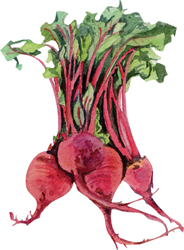
Window-box gardening is more suited, on the whole, to cut-and-come-again vegetables, such as ‘Salad Bowl’ lettuce, Swiss chard and perpetual spinach, which continually replenish themselves throughout their growing season. A single ‘Tom Thumb’ lettuce is cut once, and that’s that until the next one is sown.
Resist the temptation to buy too many plants or seeds. They all need attention, but not fragmented or diluted attention, under which they will not thrive – and neither will the sower. Growing seeds is like travelling, in that it is better to see more of less, than less of more. Your concentration acts like a fertilizer – just as it does on both humans and animals. If you stroke a person or an animal while reading or listening to the radio, your hand feels empty and automatic. Animals are particularly aware of this and, quite rightly, object. You have to remember what you are doing when sowing seeds: you are helping to perform a miracle. That something the size of a speck of dust, which can be blown away by a breeze, sneeze or sigh, needs only to be placed in or on soil to germinate is miraculous. There are vegetables to match the whole spectrum of colour, apart from blue. So why is blue mostly excluded, reserved for flowers and sky?
And how undemanding vegetables are. They will flourish in fields, suspended in mid-air in hanging baskets, in greenhouses, pots, pans, allotments, potagers, roof gardens and terraces.
Even if you have only a very small, sunny balcony or roof garden there is still room to include an orchard, or at least one miniature, self-fertile fruit tree. My roof garden started off with a ‘Comice’ and a ‘Conference’ pear, a ‘Victoria’ plum and a ‘Sunburst’ cherry, all comfortably growing in 14 x 14 x 12in (36 x 36 x 30cm) tubs. At least they are sufficiently comfortable to produce fruit.
Now is the moment to order an ‘orchard’. Trees can be planted between November and April and generally arrive with simple planting instructions.
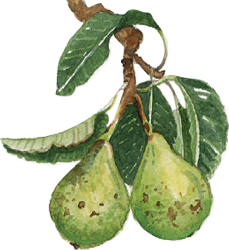
Confession number one: an orchard
Any number of fruit trees beyond three constitutes, for me, that evocative word, an orchard. Mine consists of three ‘Victoria’ plums, one ‘Brown Turkey’ fig, a ‘Sunburst’ cherry, a ‘Comice’ and a ‘Conference’ pear and a nameless now-no-longer-with-us apple tree. All are of the minarette kind and all, apart from the apple, are of that somewhat solitary, self-sufficient disposition, self-fertile.
There is only one drawback to an orchard, as far as I am concerned, and that is the problem of pruning. For some reason I seem incapable of comprehending even the simplest, most basic pruning instructions, even when lavishly illustrated. The confession: I ring the nursery which supplies my trees and with a cordless telephone held firmly between shoulder and ear, and secateurs at the ready, ask to speak to a patient assistant, who then instructs while I snip. So far this has always worked.
One of the loveliest aspects of an orchard is the spring blossom, each variety of fruit having a different flower. The apple, not being self-fertile, needed a little assistance with fertilizing. This was achieved by gently dabbing the centre of the blossom with a small soft paintbrush.
Pruning the fig tree had a rather biblical feel about it. The large, five-lobed, hand-shaped rough leaves and mysterious thick white sap made me feel I was in the Garden of Eden taking part in Genesis.
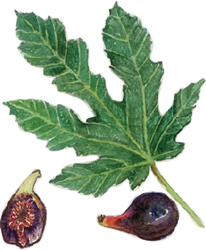
Mid-February is also the time to order saffron (Crocus sativus) corms (see page 170, G) for planting between June and August. It is important to buy C. sativus and not a subspecies or C. speciosus, which is what a lot of the so-called C. sativus corms are.
Read about saffron’s long and interesting history (for a potted version and a description of a visit to a Spanish saffron festival, see page 109).
Chitting potatoes
This means placing potatoes in an egg box and leaving them in a cool place to start sprouting (chitting) in time for planting in April.
Second parsley check
After only a few hours on the windowsill, the seedling stems will have straightened. When the sun reaches them, all members of the ensemble will lean towards it. Keep turning their tray clockwise (clockwise because it is easier to remember), so that all sides receive equal light. If seedlings respond in this way to the sun, do they respond nocturnally, too, to the moon? Some gardeners believe so and sow at night. If the moon changes people’s moods and pulls tides along, surely it influences seeds, too, pulling them out of their cases.
Scented plants
Although my ‘allotment’ consists mainly of vegetables and fruit, it was formerly a scented roof garden, so naturally there are still a few members of the scented congregation left, such as Persian lilac, Wisteria sinensis, vanilla-scented Clematis montana, Rosa ‘Zéphirine Drouhin’, freesias, a portable indoor-outdoor orange bush, Viburnum x burkwoodii, lavender and Lilium regale, which have been living contentedly in the same 8in (20cm) pots for many years. There are also three different honeysuckles, two jasmines and Trachelospermum x jasminoides ‘Japonicum’, which specializes in autumns, having two each year – the first a private one in spring, when the leaves turn bright red, and the second with all the other plants in autumn, when the leaves again become red.

Apart from the residents mentioned above, night-scented stock (which must be one of the smallest flowers to produce such a huge scent) can also be grown. It doesn’t object to being brought indoors for the evening to scent a room. Also sweet peas and mignonette, that old-fashioned-looking, grandmotherly plant. If a choice had to be made between vegetables, fruit, scented plants and plants for colour, I would put them in the above order.
For brilliance and cheerfulness there is the confetti-like Virginia stock, nasturtiums and impatiens, the last because of their clashing pink-reds and because they are supposed to be difficult to grow (or at least the Fl hybrid is). Their germination boosts horticultural confidence.
However, growing solely vegetables need not result in a colourless, flowerless garden. There are red and white bean flowers, yellow cucumber, purple aubergine, beige rocket, pale yellow pak choi and white basil flowers, to mention just a few.
Third parsley check
After a short time the first two seedling leaves will unclasp each other and stretch out horizontally. When they are all outstretched, there will be very little standing room in the seed tray. Possibly a few other seeds (generally known as weeds) will also have enjoyed the incubation period. Remove them and any weak or overcrowded parsley seedlings. This can be done either with agile fingertips or tweezers.
Do not discard the parsley seedlings – eat them. These slim, elongated leaves are unidentifiable as parsley (it is the third leaf that reveals what the plant is), except in their taste, which could be nothing else but parsley. It is astonishing that something so diminutive, which is just a few days old and has only a stem and two leaves, can be filled with its own unmistakable taste, many times more pungent than its size but occupying only a minute portion of the mouth.
Sown 28 January
First appearance 6 February
First two leaves 19 February
Third leaf revealed 21 February. This is the tiny, trifoliate leaf that announces what the plant is: not dill, wild strawberry or basil (these look completely different) but Italian flat-leaved parsley.
Observing a dried pea ‘hatching’
For several weeks the pea lay submerged in water in a little glass cup, covered in minute diamond-like bubbles. Was the pea releasing air to create these bubbles? Or where do they come from? After a time I thought the pea might rot, so I removed it from the water and placed it on blotting paper.
Pea has rather anaemic-looking beige skin which makes it resemble a stone, giving it an unyielding appearance.
I keep watching it. What, I wonder, is going on inside it? Has pea put on weight?
Finally, while I was looking in the other direction, the stone-like skin relented and split. It wasn’t a random, haphazard splitting. It was a neat little incision, as though made by a tailor. As the split widened, it looked as though a size eighteen person was trying to squeeze out of a size fourteen waistcoat.
After few more days, a minute Roman-nose-profile beak appeared between the split.
Hatching is almost complete.
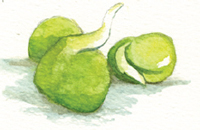
Bird Café
In the winter, when my cat died and nothing much was happening on my roof garden, I decided to concentrate on feeding wild birds, hoping I would have more success with them than the wildlife garden experiment.
From a wooden washing line – i.e, a broom handle suspended horizontally – I hung a selection of feeders, including a suet ball, a globe distributor for small birds, a fat ball guardian for larger birds, a classic seed feeder and a goldfinch starter kit. To prevent pigeons stealing the ground feeders’ food, on the ground I installed a feeding tray plus a protector which resembled a high-sided cot with lid. (My adept pigeons eat from every food source they can reach.)
The menu consisted of sunflower hearts, premium peanuts in a nylon Aertex ‘sock’, black sunflower seeds for chaffinches, nyjer seeds for siskins and goldfinches, and high-energy suet sprinkles. For a treat there was a peanut bird cake. As far as possible there was something to suit all tastes and sizes of beak and throat. I resisted buying the Cooking for Birds book.
Also suspended from the broom handle was a ceramic birdbath-cum-drinking trough. I did not buy the Grecian, neoclassical or terrazzo birdbaths or the pagoda bird table.
The Bird Café was now open. Several weeks passed. Not even a pigeon appeared.
Remembering a friend’s enviably successful relationships with a blackbird family, I followed her advice and added cheese, raisins and grapes to the Today’s Specials menu. Still no customers.
Only when I had almost given up hope did the first robin appear. Although I was longing for birds to appear, I was glad that my arms were not long enough to pluck them from the air. They came when they, not I, wanted.
The staircase leading to the roof garden was converted into a hide where I sat and watched the birds through binoculars. What other wild creatures bring so much instant, unexpected delight?
Day by day they became braver until one afternoon a blue tit flew triumphantly through my late cat’s cat flap, continuing its flight downstairs into the sitting room, where I was afraid it would crash into a window. Instead it landed on a potted stephanotis, which it examined thoroughly before flying out through another window.
A robin hopped to within inches of my outstretched hand, seemingly compelled for some mysterious reason to move closer and closer. A daring ground-feeder pigeon hung from the suspended feeders resembling a novice circus artist. With admirable perseverance it tried repeatedly to solve the problem of food behind bars.
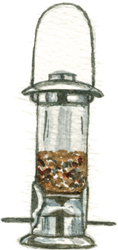
One day during spring I went to inspect my transplanted vegetable seedlings, all painstakingly reared from seed on my bedroom windowsill before being tucked comfortably into larger pots. The fragile plants had disappeared. Where were they? On the ground, wilting. But how had they got there? They couldn’t have clambered out of the pots.
Although I didn’t need any help with my 8 x 16ft (2.5 x 5m) roof garden, a blackbird had immediately appointed himself assistant gardener. Everything I transplanted he discarded, his beak flinging it and the surrounding soil on to the ground. At first I thought he might be averse to certain plants. This was not the case. Black disliked all small plants. It was like working with a delinquent adolescent gardener on work experience. When I was not trying to rescue the discarded transplants, I was sweeping up after him, our job descriptions reversed, I having become his full-time assistant. How, I marvelled and fumed, can such a tiny, yellow implement and two small feet do so much damage and how can something smaller than my hand contain so much persistence and strength?
To distract Black from his gardening activities I concocted a playpen, which I filled with fresh compost topped with leaves, having been told that blackbirds enjoy delving into them for worms while kicking them up and creating leaf fountains. Needless to say, Black ignored the playpen, just glancing at it sharply over his shoulder before continuing his determined digging. His reaction was similar to my cat’s when I bought a toy for her, her expression one of condescension, as though enquiring who I imagined was going to play with it.
After completing his clearance work, Black turned to archaeology. With his legs apart and his head lowered in concentration, he plunged his beak yet further into the soil, excavating it. He was assisted by his two fledgling offspring, though there was nothing baby bird-ish about this couple. They were large, untidy and had squeaky voices. It was impossible to imagine they would ever develop into soloists. They stood close together on their spindly legs, absorbed in watching their manic father.
The last straw was when I discovered that the bedroom window-box, which was planted with basil, dwarf beans, dill and tomatoes, had been ransacked, the young giraffe-like dill plants left gasping for soil. I keep the window wide open all summer so that the tomatoes can be plucked from the bed and made into basil and tomato sandwiches. Not only were all the plants wrenched up but soil was spattered over the white duvet. The only solution, I concluded reluctantly, was to cover the containers with plastic netting.
I began by making individual container covers. As this required the skill of a tailor, which I don’t possess, I changed the design and made a series of multi-container hairnet-like covers. But even these had to be gathered at the bottom and, using a needle and twine, tied with a bow. Although the hairnets kept some of the birds out, they also kept the plants in, distorting their growth, particularly the raspberries, which struggled against the netting like prison inmates.
There had never been any trouble sharing the roof garden with cats; none of them had ever mistaken the tubs for litter trays. Now I could barely see out of the bedroom window and, covered in this bridal netting veil, the roof garden resembled something designed by Miss Havisham.
A day after installing the ‘prison’, who was happily digging away on the inside of the high security net but Black? How had this Houdini-in-reverse managed to get in? And equally important, how was he going to get out without panicking and injuring himself? To tempt him away from his digging and to compensate for the now-forbidden garden, I made him a Special Menu order of pre-soaked and chopped raisins, waiting until the hot soaking water cooled because he was apt to stomp about in the bowl.
While Black ate the raisins, feeding some of them to his now outsize dishevelled ‘babies’, I searched for his secret route into the prison. It was then that I discovered some mysterious molehills on the surface of the soil. Had Black progressed from archaeology to constructing cairns? I never saw him working on his new hobby, and it was doubtful that he did it during the night. I flattened the molehills. Mysteriously, the next morning there they were again.
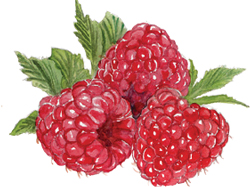
It was at this time that I had planned to go on holiday. At least, I had assumed, with wild birds there wouldn’t be the worry there was with cats when leaving them. I filled all the feeders to their brims and left.
On my return the feeders were empty. But where were the birds? Although the garden was bursting with growth, the birds’ lively presence had been replaced by an emptiness far greater than their size, and a silence so loud it was almost a sound in itself. I felt bereft, realizing that one should never take wild birds for granted. I rattled the seed tins, grated cheese, soaked raisins and diced bread. Nothing would induce them to appear. Apparently some people’s cats sulk when their owners return from having been away. Mine never sulked. Were the birds sulking? It is not an emotion one associates with birds.
Eventually they relented and gradually started to return. Where had they been, what had they seen and what had they been doing? This time, though, they were accompanied by another form of wildlife, the makers of the molehills: ‘field’ or ‘wood’ mice, I called them, because I couldn’t bear to think that they might be house mice.
As gardeners they were as bad as Black. The molehills were in fact entrances to a metro system they were busy installing inside the containers. I tried flooding them with a hose but they immediately brought in a metro maintenance team and dug new tunnels. Fortunately their burrowing activities were nocturnal, so although I knew they were there I never saw them, until … One warm summer evening I saw a ‘field’ mouse doing a tight-rope walk across the broom handle en route to the Bird Café. The following evening a mouse slid down the metal feeder guard as though it was practising in a gym.
Before becoming totally panic stricken by the arrival of the mice, to which I am hyper-allergic, I tried to find out what sort they were, naively believing that field and wood mice were preferable because they have large ears, emotional eyes, are vegetarian and prefer to live outdoors. I rang the Natural History Museum, hoping that they would say they were anything but house mice. They suggested I should look them up on the Web and compare the pictures. I didn’t like to admit that I can’t even bear looking at mouse pictures, let alone dwelling on their differences. The museum quickly put an end to my field/wood mice preference by saying that they are not fussy where they live as long as it is warm. Equally disturbing was to be informed that their tails are probably even longer than those of house mice. If mice didn’t have these long, generally semi-naked, trailing tails they wouldn’t be so bad. Also, if they could only amble or saunter along instead of dashing everywhere, it would be a great improvement.
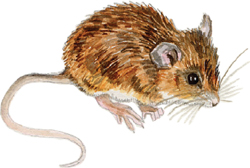
I then rang the RSPB. Was I the only person running a café for birds and mice? Were the two inseparable? Surely I wouldn’t have to do anything as drastic as closing the café. What did other people do?
They advised cutting down on the catering, i.e. reducing it to a one-course meal once a day, preferably an early breakfast with only one sitting. What was essential was to clear up thoroughly after breakfast, leaving nothing for the mice. I followed the RSPB’s suggestions.
I then had to go away for a fortnight, which I knew would involve the initial bird sulking period on my return, but at least the roof garden should be mouse free.
Fourteen days later I returned late at night after a long flight. Fortunately I pulled back the duvet cover, rather than just plunging into bed. Curled up comfortably in the middle of the bed was a very surprised, half-asleep mouse, which had obviously been using the bed as an en-suite bedroom. But this wasn’t the only place the mice had visited.
I tried various methods to encourage them to leave. But they, like the blue tits, were now using the cat flap and no longer darting about, but just strolling around. Unfortunately, the only solution was the council’s pest control department. They brought little cup-cake-size saucers of bright turquoise poison, which they distributed round the flat. The mice ate the poison as though it was a dessert.
A couple of weeks later the problem resolved itself: I was adopted by yet another cat-flap visitor. I was busy cooking and looked down to see a stray cat looking intently up at me, as though at a cookery demonstration. Since then we have been happily mice-less but sadly bird-less.
Apart from all-year-round parsley, and possibly tomatoes, there are a few other seeds that can be sown this month, though don’t be tempted to do this too early. Seedlings don’t like the cold, or standing around on a windowsill becoming leggy before being taken outside. Those who live on the Shetland Islands will start sowing later than those on the Scilly Isles.
Garlic chives (February–April)
Basil, bush (Ocimum minimum) (February–April)
Basil, sweet (Ocimum basilicum) (February–April)
Alpine strawberry (Fragaria vesca ‘Semperflorens’) (February)
Busy Lizzies (Impatiens walleriana) (mid-February–April)

WHAT TO EAT NOW
Ten-minutes-to-prepare Roman bread
This recipe is a good way to exercise hands in preparation for all the work they will be doing during the following months in the allotment. It is called Ten-minute Roman bread because this is the time it takes to weigh out the ingredients, mix and knead them. The rest of the work (apart from the rising which the dough does on its own) is done by the oven.
1 lb (450 g) organic Spelt flour
(Triticum spelta, an ancient precursor of modern wheat varieties)
1 x ¼ oz (7g) sachet Easy-Bake or Fast-Action yeast
1 tsp (5 ml) sea salt
1 tbsp (15 ml) sunflower or olive oil
¾ pint (425ml) warm water – ¼ pint or 150 ml of boiling water from the kettle, the rest from the cold tap; this mixture gives just the right temperature
Preheat the oven to 190°C/375°F/Gas mark 5. Oil a baking tray measuring approximately 13 x 9in (33 x 23cm). Place the flour, yeast, salt and oil in a large bowl. Mix gently. Add the water bit by bit while stirring with your hand. Some flours are thirstier than others. When the dough ball leaves the sides of the bowl, turn on to a flat surface and knead until the dough feels springy. Form into a ball – or any other shape you like. Place in the centre of the tray. Cover with a clean cloth and leave to rise in a warm place (i.e. near the oven). The rising will take 30–45 minutes. Bake in the preheated oven on a middle shelf for 30–35 minutes. A cooked loaf will sound hollow when tapped underneath. Cool the loaf on a wire rack. Resist slicing the bread until it is completely cold.
Variations
You can try different flours, using half white and half brown, all white or all brown flour, adding rye flour, cornmeal or other grains. A whole variety of seeds, nuts and fruits can be included when mixing the dough. These include: poppy seeds (black and white), pumpkin seeds (with or without a tamari coating), sesame seeds, sunflower seeds, sunflower hearts, hazelnuts, pine nuts, almonds, walnuts, brazils, raisins, currants, sultanas and olives (black and green). Nuts and seeds can be toasted or untoasted. A generous handful or two will be sufficient. The surface of the loaf can be left bare or, just before it is put into the oven, sprinkled with flour or painted with egg yolk or white. The surface can also be quickly and gently wetted with warm water – just sufficient to make seeds or grains stick. It can then be sprinkled with sesame seeds, poppy seeds, polenta, soaked wheat grains, cracked wheat or golden linseed.
